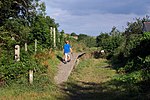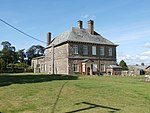Marland Works railway station

Marlands Works was a busy industrial site for just over a century, firstly on the Torrington and Marland Railway, built to carry bricks and clay on a three-feet gauge, which in turn was subsumed in 1925 by the North Devon and Cornwall Junction Light Railway before finally becoming part of the Southern Region of British Railways in 1948. The line closed to passenger traffic in 1965 as part of the Beeching reforms but the line remained open for freight between Barnstaple railway station and Torrington until 1982. Today it forms part of the popular Tarka trail, although an important site for industrial railway historians too. Marland Works station was used by workmen only and was not in public passenger use.
Excerpt from the Wikipedia article Marland Works railway station (License: CC BY-SA 3.0, Authors, Images).Marland Works railway station
Torridge District Peters Marland
Geographical coordinates (GPS) Address Nearby Places Show on map
Geographical coordinates (GPS)
| Latitude | Longitude |
|---|---|
| N 50.8918 ° | E -4.1315 ° |
Address
EX38 8QD Torridge District, Peters Marland
England, United Kingdom
Open on Google Maps









